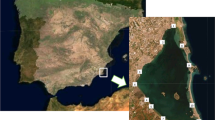Abstract
Although a number of metal speciation methods are nowadays available, most water quality regulations are based on total metal concentrations. One of the main reasons for the ignorance of speciation is the lack of methods with potentiality for monitoring. Conditions that have to be met by such speciation methods are: simple performance, robust and sufficiently accurate. In this study the potential for monitoring purposes of Diffusive Gradients in Thin films (DGT) is investigated as part of a European project for sensor development for routine prediction of metal biouptake in natural waters. Performance characteristics of DGT have been assessed in experiments under controlled laboratory conditions and during in situ application over 4–9 months under different hydrological conditions in the rivers Meuse and Rhine. Results have been worked out for Cu, Ni and Pb. The study shows that DGT has sufficient potential as a robust tool in routine monitoring to observe trends in water quality. However, it appears that during in situ application of DGT the measurement uncertainty of the results is much larger than under laboratory conditions. The increase in measurement uncertainties will partially be due to uncertainties in some as constant considered factors in the calculation of the DGT concentration. For Cu and Ni, the average values for the reproducibility in the rivers Meuse and Rhine appeared to be 28% and 17%, respectively, whereas under laboratory conditions the reproducibilities for both metals were better than 10%. In the speciation of Cu, Ni and Pb in the rivers Meuse and Rhine, the labile fraction, determined using DGT, decreased in the series Ni, Cu, Pb. The ratio of the non-labile and labile fractions of the metals appeared to decrease with increasing content of Dissolved Organic Carbon (DOC).
Similar content being viewed by others
References
Alfaro De La Torre, M. C., Beaulieu, P. Y. and Tessier, A.: 2000, ‘In situ measurement of trace metals in lakewater using the dialysis and dgt techniques’, Anal. Chim. Acta 418, 53–68.
Buykx, S. E. J., Cleven, R. F. M. J., Hoegee-Wehmann, A. A. and van den Hoop, M. A. G. T.: 1999, ‘Trace metal speciation in European river waters’, Fresenius’ J. Anal. Chem. 363, 599–602.
Davison, W. and Zhang, H.: 1994, ‘In situ speciation measurements of trace components in natural waters using thin-film gels’, Nature 367, 546–548.
Davison, W., Fones, G., Harper, M., Teasdale, P. and Zhang, H.: 2000a, ‘Dialysis, DET and DGT. In situ diffusional techniques for studying water, sediments and soils’, in J. Buffle, and J. Horvai (eds), IUPAC Ser. Anal. Phys. Chem. Environ. Syst., 6: In Situ Monitoring of Aquatic Systems, John wiley & Sons, Ltd, New York, NY, USA, pp. 495–569.
Davison, W. and Zhang, H.: 2000b, ‘In situ measurement of labile species in water and sediments using DGT’, Ocean Sci. Technol. 1: Chemical Sensors in Oceanography, 283–302.
Denney, S., Sherwood, J. and Leyden, J.: 1999, ‘In situ measurements of labile Cu, Cd and Mn in river waters using DGT’, Sci. Total Environ. 239, 71–80.
RIVM: 2003, ‘Kwaliteitshandboek’, Quality Handbook of the Laboratory for Inorganic Analytical Chemistry, Bilthoven.
RIZA: 1999, ‘Twice A River, Rhine and Meuse in the Netherlands’, RIZA Institute for Inland Water Management and Waste Water Treatment, RIZA Report 99.003, Lelystad.
Van Leeuwen, H. P.: 1987, ‘Voltammetric titrations involving metal complexes: Effect of kinetic and diffusion coefficients’, Sci. Total Environm. 60, 45–55.
Van Leeuwen, H., Cleven, R. and Buffle, J.: 1989, ‘Voltammetric techniques for complexation measurements in natural aquatic media’, Pure & Appl. Chem. 61, 255–274.
Van Leeuwen, H.: 2000, ‘Speciation dynamics and bioavailability of metals’, J. Radioanal. Nucl. Chem. 246, 487–492.
Warnken, K. W., Zhang, H. and Davison, W.: 2004, ‘Performance characteristics of suspended particulate reagent-iminodiacetate as a binding agent for diffusive gradients in thin films’, Anal. Chim. Acta 508, 41–51.
Zhang, H. and Davison, W.: 1995, ‘Performance characteristics of diffusion gradients in thin films for the in situ measurements of trace metals in aqueous solution’, Anal. Chem. 67, 3391–3400.
Author information
Authors and Affiliations
Corresponding author
Rights and permissions
About this article
Cite this article
Cleven, R., Nur, Y., Krystek, P. et al. Monitoring Metal Speciation in The rivers Meuse and Rhine Using DGT. Water Air Soil Pollut 165, 249–263 (2005). https://doi.org/10.1007/s11270-005-5147-0
Received:
Accepted:
Issue Date:
DOI: https://doi.org/10.1007/s11270-005-5147-0




